

Hanging the Airplane Wings
Hanging the airplane wings on my RV-8 was one of the most exciting days in the construction. With the wings on, it actually looked like an airplane instead of just parts of one. It takes a little doing to get the holes lined up and bolts in, so you will want to remove and re-install the wings as few times as possible. Prior planning is very important. Make sure you have everything ready before you start. Are you ready to make the fairings? What about the fuel and vent lines? If your pitot line pokes out of the wing, have you drilled the hole in the fuselage for it? You don’t want to get half way through hanging the wings just to find out they have to come back off. I did most of the work on the fuselage with it sitting on a pallet. This put it at the right height for me to easily reach inside. But to initially fit and drill the airplane wings, the crate was too low. I couldn’t get underneath to drill the holes for the center bottom skins. I used the shipping crate Vans used to send me the weldments. I put a couple short 2x4s across the top to put the weight of the fuselage on the sides of the crate instead of just on the thin plywood top. You need to ensure the fuselage is level in both directions. Use a level across the center spar section, and on the rear deck if you haven’t already installed the tail, or on the F-887 upper longeron at the canopy rail. Mark the holes you left open on the inboard edge of the bottom wing skins by drawing a line from the holes outboard. Mark 3” up the line from the hole. Once you have the wing in the fuselage, these marks will help you locate the hole as you drill through the center bottom skins. I used four hardware store bolts that were tapered on a grinder to help align the holes and four more as temporary bolts to hold the airplane wings during the initial fittings. A liberal dose of general-purpose grease on the wing spars, and on the tapered and regular bolts, made everything slide a lot easier. As you install the wing, start with the wing spar a little above the lower skin so that as you push it into the fuselage, the bottom edge of the spar doesn’t scrape and mar the inside of the skin. I had help holding the airplane wings while I was inside the fuselage, inserting the pins. I started with one of the tapered pins in a top hole. Once it went all the way in, we rocked the wing up and down until a lower tapered pin went all the way in. Then I used the hardware store bolts to drive the tapered pins out, at the same time, leaving the bolts in the holes. After both wings are in, check that the fuselage is still level.
I pushed the rear wing spars farther into the fuselage and used small C-clamps to hold them. Then realigned the plumb lines and the string across the floor. I repeated this until I had all four plumb lines just barely touching the aft side of the horizontal string. This put the airplane wings in line, but didn’t assure the line was perpendicular to the fuselage centerline.
Then I rechecked the four plumb lines. After this, minor tweaking was required until I got all four plumb lines just kissing the horizontal line, and the two wing measurements within 1/32 of an inch. The book says ½ inch difference is ok, as long as the wing sweep of both airplane wings is the same. I think that any error you leave in here will create drag and cause your plane to fly slower. The extra time spent realigning and checking until you get the measurements as close as possible is well worth it. Before you start setting the wing incidence, make a mark on the aft side of the F-806D and the W-807D rear spar to show proper alignment. Remember that when you unclamp the C-clamp, the wing will move back in or out, and all your previous hard work will be lost. Make the mark so you can easily slide the aft spar in or out as required to get back to the proper sweep. Now set the incidence on each wing by pushing the aft end up or down as required. Here is where that mark you made on the rear spar comes in handy. I used the shim and level measurement as depicted in the plans. But I also checked that the flap fit nicely to the bottom of the fuselage. After I had set the incidence with the shim and level, I installed the flap and checked that with the flap in the trail position, the bottom skin lined up with the belly of the fuselage. The incidence can be a little off of the perfect 1/2° positive angle; the important thing is that both airplane wings have the same incidence. Go back and recheck all the other measurements before you drill the hole in the rear spar. This is the last chance to make any changes.
You can use the spacer you made for the hole in the elevator control horns to keep your drill square. I have a drill with a level in the handle. I used this to ensure I was level and a small square to ensure I kept the drill perpendicular to the spar. After the hole was drilled, I inserted a temporary bolt to hold the position. The bottoms of my W-807s stuck down too far, and were interfering with the lower skins. So I marked the bottom edges of the F-806s on the W-807s and removed the airplane wings. Then I ground off the extra metal so the W-807 would be flush with the bottom of the F-806. I then smoothed and primed the W-807s. This left a lot of metal chips stuck to the old grease on the main spars. It was a lot of work to clean them up. I would suggest wrapping them with some old plastic bags during the grinding work. After everything is blown off, you can remove the plastic bags and the greasy main spars are ready to be inserted in the fuselage again. Those lines you made on the lower wing skins come in handy now to locate the holes that need to be drilled. Because you are drilling them larger than the pilot holes, if you miss the dead center a little, it is OK.
At this point, I made all the fuel and vent lines to connect the tanks to the fuselage. But I made the mistake of leaving them in place when I drilled the fairings, and nicked one of the vent lines with the drill bit. Be careful, or be smart enough to remove them before you drill. I fit the fairings before I removed the wings. But I waited until the next time I hung the wings (for the final time) to rig the ailerons.
Return from Hanging the Airplane Wings to Fuselage Return from Hanging the Airplane Wings to Kit Plane Advice Home |
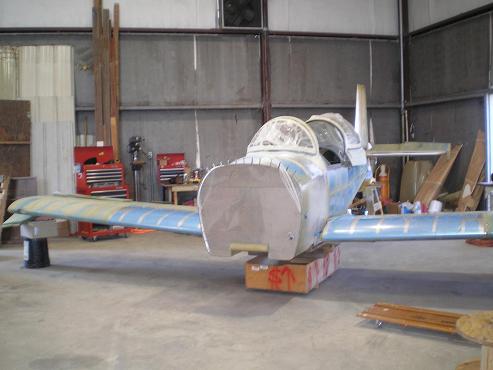
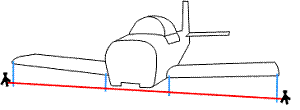 I started the wing
alignment by
dropping four plumb lines
from the front of the wings—two from the wing tips, and two at the wing
roots
(this means the tanks have to be installed.)
I started the wing
alignment by
dropping four plumb lines
from the front of the wings—two from the wing tips, and two at the wing
roots
(this means the tanks have to be installed.)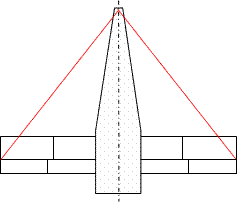 To get everything
perpendicular, I
measured from the
intersection of the top wing skin and the forward skin at the wingtip
to a
center rivet on the top of the turtle deck. I divided the total
difference in
the two measurements in half.
To get everything
perpendicular, I
measured from the
intersection of the top wing skin and the forward skin at the wingtip
to a
center rivet on the top of the turtle deck. I divided the total
difference in
the two measurements in half.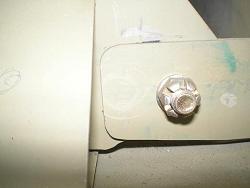 The
warning in the plans is why I
suggested you don’t remove
any metal from the F-806 rear spar parts when you put the
The
warning in the plans is why I
suggested you don’t remove
any metal from the F-806 rear spar parts when you put the 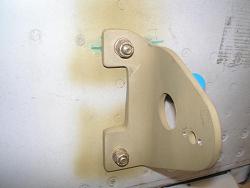 When
you make the F-863 attachment
brackets, don’t remove
all the metal on the fuselage side until after you drill the two holes.
When
you make the F-863 attachment
brackets, don’t remove
all the metal on the fuselage side until after you drill the two holes.